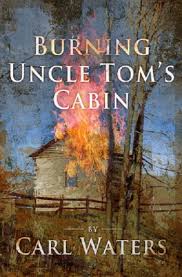Author Carl Waters calls BURNING UNCLE TOM’S CABIN a reimagining of Harriet Beecher Stowe’s classic Uncle Tom’s Cabin from minor character George Harris’ point of view. As Waters states in the book’s preface, modern readers often have a difficult time understanding Uncle Tom’s acceptance of his lot as a slave sold down the river from an antebellum Kentucky plantation. The subplot of husband-and-wife slaves George and Eliza’s flight to freedom in Canada is understandably more compelling to a contemporary audience, both in Stowe’s book and as the primary action of Waters’ book.
Readers familiar with Uncle Tom’s Cabin will recognize many of the touchstones of that book, but readers who’ve never read Stowe’s book will find BURNING UNCLE TOM’S CABIN an easy read as well. Waters whittles away at Stowe’s dense period prose, revealing the breathless action of the story and making the characters come alive.
Updating Stowe’s story is a great idea, but Waters sometimes seems to forget where to draw the line. BURNING UNCLE TOM’S CABIN’S prose veers between historically accurate and modern, sometimes within one scene. Eliza remarks that the “lights are still on” in a slave cabin, and later in the book, she and George discuss “Plan A” and “Plan B.”
Some of the historical detail could have used a bit more finesse, as well. The best example is the Fugitive Slave Act, which allowed slave owners to have escaped slaves tracked and returned even from free states. Every mention of it seems clunky, as not enough information and background is given to make readers who are not familiar with the controversial act’s history understand why it’s so important to the story. A discussion of the Fugitive Slave Act in the preface would easily have solved this problem.
The problems with historical voice may be due to the book’s intended audience; Waters mentions in the preface that he’d originally set out to write a young adult series, and although BURNING UNCLE TOM’S CABIN is marketed as historical fiction, it’s appropriate for the YA audience, as well.
BURNING UNCLE TOM’S CABIN is the first in a series of books that will reimagine Stowe’s work from several viewpoints, and ends with an epilogue that sets up the next book. Starting with George and Eliza’s story gets the series off to an exciting, fast-paced start.
Reviewed by J.E. Cornett for IndieReader

